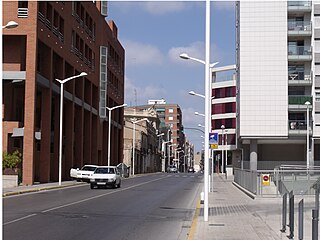
Villarreal is a city and municipality in the province of Castellón which is part of the Valencian Community in the east of Spain.

Callosa d'en Sarrià (Valencian:[kaˈʎozaðensariˈa] is a Valencian town and municipality located in the comarca of Marina Baixa, in the province of Alicante, Spain, lying in the valley of the river Guadalest, 50 km from the city of Alicante. Callosa d'en Sarrià has an area of 24.8 km2 and according to the 2003 census, a total population of 8,060 inhabitants. The economy of Callosa is chiefly based on tourism and agriculture: it is the main producer of loquat in Spain. The most important monuments in the town are the Catholic archipresbyteral church of Sant Joan Baptista, built in the 18th century, and the Fortress of Bèrnia, built in the 17th century at the top of a nearby mountain to defend the city from pirates and Moriscos.

Mislata is a city in the Valencian Community, Spain. It has borders with the city of Valencia and Quart de Poblet in the west and Xirivella in the south.

Horta Nord is a comarca in the province of Valencia, Valencian Community, Spain.
Alfarb is a municipality in the comarca of Ribera Alta in the Valencian Community, Spain.

Alaquàs is a municipality in the Horta Oest comarca in the Valencian Community.

Foios is a municipality in the comarca of Horta Nord in the Valencian Community, Spain. It has a population of 7,342.
Moncada is a municipality in the comarca of Horta Nord in the Valencian Community, Spain.

Náquera is a municipality in the region (comarca) of Camp de Túria in the Valencian Community, Spain; placed in the NE of the province of Valencia at a distance of 24 km from Valencia. The main church is Nuestra Señora de la Encarnación.

Paterna is a city and a municipality in the province of Valencia in the Valencian Community, Spain. It is located northeast of the comarca of L'Horta de Valencia, 5 kilometres northwest of the inland suburbs of Valencia, and on the left bank of the river Turia. Its population in 2014 was 67,156 inhabitants, being the eleventh city by population in the Valencian Community.

Puçol is a Spanish municipality located in the province of Valencia, part of the Valencian Community autonomous region. It belongs to the Horta Nord. The municipality borders El Puig south and Sagunt to the north. It has 19,975 inhabitants (01/01/2021), of whom 9,839 are men and 10,136 are women.

Quart de Poblet is a municipality in the comarca of Horta Oest in the Valencian Community, Spain. It has 25,499 inhabitants.

Valencia, natively also València, is a province of Spain, in the central part of the autonomous Valencian Community. Of the province's 2.6 million people (2021), one-third live in the capital, Valencia, which is also the capital of the autonomous community and the 3rd biggest city in Spain, with a metropolitan area of 2,522,383 people it is also one of the most populated cities of Southern Europe. There are 265 municipalities in the province.
Manuel Palau Boix was a Spanish composer and teacher in Valencia Conservatory. He wrote a large number of symphonic, band, choral and chamber works. He was one of the most popular and important composers of his time. He received the Spanish National Music Award twice, first in 1927 and again in 1945. His music is known within the Spanish classical music for being a representative of what it has been called “Mediterranean” style, like other Spanish musicians such as Vicente Asencio or Oscar Esplá.

The Carraixet ravine is a course of water from the north of the Valencian province, in the Valencian Community (Spain). It begins in Gátova and collects waters from the sloped southern side of the Calderona mountain range. It flows into the Mediterranean Sea through the town of Alboraya. At its mouth, it is also called the Olocau ravine or the Peralvillo ravine. In the Book of the Facts James I named it riu Sec, while discussing the Battle of the Puig.

The Ojos Negros Greenway, is a 160-kilometre greenway in Spain running between the village of Santa Eulalia del Campo in the province of Teruel in Aragón and the village of Algimia d'Alfara, in the province of Valencia in the Valencian Community.

Pobles del Nord is the 17th district of the city of Valencia (Spain). It is composed of seven towns, which were annexed to Valencia between 1888 and 1900, which are today considered neighborhoods: Benifaraig, Pueblo Nuevo, Carpesa, Casas de Bárcena, Mahuella, Tauladella, Rafalell i Vistabella, Masarrochos and Borbotó.
Pueblo Nuevo is a pedania in the city of Valencia (Spain) belonging to the district of Pobles del Nord. It is bordered on the west by Burjassot, on the north by Borbotó and Carpesa and on the south by Valencia. Its population census in 2022 was 908 inhabitants.

Benifaraig is a pedania of the city of Valencia (Spain), belonging to the district of Poblados del Norte. It is bordered on the west by Godella, on the east by Alfara del Patriarca, on the north by Moncada and on the south by Borbotó and Carpesa. Its census population in 2022 was 993 inhabitants. It was an independent municipality until 1900, when it became a pedania of the city of Valencia.

















